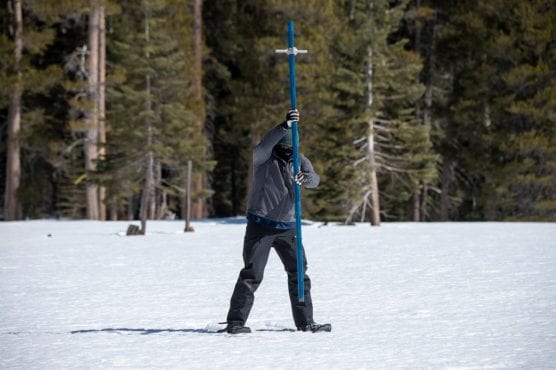After a relatively dry February in California, water supply managers grow increasingly anxious as each dry, sunny day plunges the state deeper into drought.
The California Department of Water Resources conducted its statewide water survey Tuesday and found the Sierra snowpack is at approximately 54% of its April 1 average. That date marks the point at which Sierra snow is typically at its peak.
“While we can’t predict how much precipitation California will receive for the rest of this year, it’s safe to say without a series of storms we will end this year dry,” said Sean de Guzman of the water department during Tuesday’s survey.
De Guzman held a snow survey at Phillips Station near South Lake Tahoe and found the snowpack there is more robust than around the state. With about 56 inches, Phillips Station boasts a snowpack that is 86% of average.
The was de Guzman’s only good news of the day.
As February failed to deliver any major storms and the forecast for early March lacks significant wet weather, water officials are starting to fret the state may be entering yet another period of prolonged drought.
“As California closes out the fifth consecutive dry month of our water year, absent a series of strong storms in March or April we are going to end with a critically dry year on the heels of last year’s dry conditions,” said Karla Nemeth, director of the water department.
Last year, dry conditions also persisted during the wet portion of California water year. The state, which enjoys a Mediterranean climate characterized by dry warm summers, receives most of its water in December, January, and February. This year, those months and the previous two disappointed water managers and without the so-called “March Miracle,” mass water conservation projects and disappointed farmers may be on tap.
“With back-to-back dry years, water efficiency and drought preparedness are more important than ever for communities, agriculture and the environment,” Nemeth warned on Tuesday.
De Guzman said the effect of two consecutive dry years is starting to manifest in the interconnected system of reservoirs that comprise the state’s water storage infrastructure.
“With below-average precipitation across the state, California’s reservoirs are starting to see the impacts of a second consecutive dry year,” he said.
Lake Shasta, the largest reservoir by volume, currently sits at 66% capacity while Lake Oroville is 55% capacity. Normally, water managers would look for those reservoirs to be at or near their capacity as the winter moves into spring.
De Guzman said that this water year is shaping up to be like the one in 2014, when California was in the middle of a prolonged 5-year drought that devastated farms, incurred mandatory conservation programs, and dried out vegetation, paving the way for the two worst fire seasons in the Golden State’s history.
Some scientists argue California never really left that drought, with the current period just an extension even as anomalous wet years bringing brief, albeit much-needed respite.
Currently, the U.S. Drought Monitor lists 99% of the state in a category of abnormally dry conditions, with 84% of the state in drought. More concerning, at least 30% of the state is in extreme drought, according to the agency.
Forecasts promise little relief.
“While occasional brief and light precipitation events are possible across California over the next few weeks, models are unfortunately painting a continued drier-than-average picture for spring 2020 due to the persistence of North Pacific high pressure,” said Daniel Swain, a climatologist with UCLA.
Precipitation falling as snow in the mountains is critical to the water supply in California because it allows the water to fill the reservoir system incrementally throughout the spring and early summer as the snow melts.
California homes, businesses, and farms receive two-thirds of their water supply from the snowpack in Sierra Nevada.
— By Matthew Renda, CNS
Like this:
Like Loading...
Related





 Tweet This
Tweet This Facebook
Facebook Digg This
Digg This Bookmark
Bookmark Stumble
Stumble RSS
RSS


























REAL NAMES ONLY: All posters must use their real individual or business name. This applies equally to Twitter account holders who use a nickname.
0 Comments
You can be the first one to leave a comment.